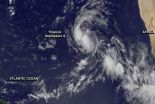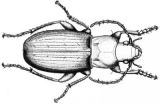(Press-News.org) The sixth tropical depression of the Atlantic Ocean Hurricane Season formed in the Eastern Atlantic Ocean and NOAA's GOES-East satellite captured it.
A visible image of Tropical Depression 6 was taken by NOAA's GOES-East satellite at 7:45 a.m. EDT on September 11 as it developed. The image was created by NASA/NOAA's GOES Project at the NASA Goddard Space Flight Center in Greenbelt, Maryland.
In addition to using GOES imagery and data from other NOAA and NASA satellites, The National Hurricane Center also uses measurements from the Advanced Scatterometer or ASCAT instrument that flies aboard the EUMETSAT METOP satellite. Forecaster Beven at the National Hurricane Center noted "Satellite imagery and a recent ASCAT-B overpass indicate that the low pressure area over the eastern Atlantic has a well-defined circulation and organized convective banding near the center."
At 11 a.m. EDT Tropical Depression Six had maximum sustained winds near 35 mph (55 kph) and the depression could become a tropical storm later in the day. The center of Tropical Depression Six was located near latitude 16.2 north and longitude 37.1 west, about 870 miles (1,400 km) west of the Cape Verde Islands. The depression is moving toward the northwest near 13 mph (20 kph) and is expected to move northwest or west-northwest is expected during the next couple of days. The estimated minimum central pressure is 1007 millibars.
Despite being in an area of wind shear, the NHC noted that computer model guidance forecasts slow but steady strengthening.
INFORMATION:
Satellite view of newborn Atlantic Tropical Depression 6
2014-09-11
ELSE PRESS RELEASES FROM THIS DATE:
NJIT researchers working to safeguard the shoreline
2014-09-11
An NJIT research team has estimated the total mass of oil that reached the Gulf of Mexico shore in the wake of the BP Deepwater Horizon blowout. It's the first time such an estimate was reported, and the study is published in the August issue of Environmental Science and Technology.
The researchers found that 22,000 tons of oil reached the Gulf shoreline in 2010. This finding will help officials determine the persistence of oil on the shore and identify potential harm to the ecosystem.
The study was conducted by the Center for Natural Resources Development and Protection ...
Penn Medicine bioethicists call for greater first-world response to Ebola outbreak
2014-09-11
PHILADELPHIA – Amid recent discussion about the Ebola crisis in West Africa, Penn Medicine physicians say that high-income countries like the United States have an obligation to help those affected by the outbreak and to advance research to fight the deadly disease — including in the context of randomized clinical trials of new drugs to combat the virus. The two new editorials, which will appear "online first" in JAMA on September 11th, are written by faculty members in the Perelman School of Medicine at the University of Pennsylvania and the Department of Social Science, ...
Unusual host preference of a moth species could be useful for biological control
2014-09-11
A team of Iranian researchers from the Rice Research Institute of Iran have discovered that Gynnodomorpha permixtana, a well-known moth species from Europe and Asia, has changed its host preferences in order to adjust to Iran's northern region environmental conditions. The importance of this adaptation for biological control of problematic weeds in rice fields and the biology of the moth on new host plant have been described in the open access journal Nota Lepidopterologica.
The larvae of G. permixtana have been so far reported to feed on the seeds and flowers of plant ...
Ebola paper demonstrates disease transmission rate
2014-09-11
Sept. 11, 2014 - New research from Arizona State University and the University of Tokyo that analyzes transmission rates of Ebola in West African countries shows how rapidly the disease is spreading.
Researchers Gerardo Chowell-Puente, ASU School of Human Evolution and Social Change Associate Professor, and Hiroshi Nishiura of the University of Tokyo found that transmission rates for each single case of Ebola consistently showed at least one new case of the disease being transmitted. Country-specific analysis of transmission rates in Liberia and Sierra Leone showed on ...
Some male scientists willing to forsake careers for family
2014-09-11
One third of men in academic science are willing to scale back their careers to focus on family life, according to researchers.
While traditional fatherhood roles may be shifting, men in the male-dominated field of academic science, such as physics and biology, face significant challenges in trying to balance work and family life, said Sarah Damaske, assistant professor of labor and employment relations and sociology, Penn State. The majority of men studied spoke of the pull of fatherhood and a desire to spend more time with children, yet they also acknowledged that academic ...
Not enough vitamin B1 can cause brain damage
2014-09-11
MAYWOOD, Ill – (Sept. 11, 2014) A deficiency of a single vitamin, B1 (thiamine), can cause a potentially fatal brain disorder called Wernicke encephalopathy.
Symptoms can include confusion, hallucinations, coma, loss of muscle coordination and vision problems such as double vision and involuntary eye movements. Untreated, the condition can lead to irreversible brain damage and death, according to neurologists at Loyola University Medical Center.
In the developed world, Wernicke encephalopathy typically occurs in people who have disorders such as alcoholism and anorexia ...
Investigators from Montefiore and Einstein to present data at 2014 ASTRO Meeting
2014-09-11
NEW YORK (September 10, 2014) – Members of the Department of Radiation Oncology at Montefiore Einstein Center for Cancer Care (MECCC) and Albert Einstein College of Medicine of Yeshiva University's NCI–designated Albert Einstein Cancer Center will present new study findings at the 56th Annual Meeting of the American Society for Radiation Oncology (ASTRO) revealing the impact socioeconomic status has on radiation treatment compliance, predictive indicators for clinical outcomes and on radiation therapy duration and dosing recommendations. ASTRO is being held September 14 ...
Two new species of carabid beetles found in Ethiopia
2014-09-11
There are more than 150 species of beetles in the genus Calathus, 17 of which have only been found in the mountains of the Ethiopian Highlands. Now scientists have found two new ones — Calathus juan and Calathus carballalae — and have described them in Annals of the Entomological Society of America.
C. juan is named for Juan Novoa, the son of one of the authors, in recognition of his help on various beetle-collecting expeditions. Adults are black and shiny, and are 9.5-11.5 millimeters long. It was found under stones at the base of giant, tree-like plants called lobelias ...
How salt causes buildings to crumble
2014-09-11
This news release is available in German. Historic stone buildings are tourist magnets. The Jordanian rock city of Petra, the medieval town of Rhodes in the Aegean Sea and the sandstone temples at Luxor, Egypt, for example, attract hundreds of thousands of visitors each year. These cultural assets all have one thing in common: they suffer from weathering caused by salts. These crystallise inside the porous building materials and generate enough force for the stone to break or crumble. The same problem also occurs in concrete buildings in this country.
Researchers at ...
Ticks that vector Lyme disease move west into North Dakota
2014-09-11
According to the U.S. Centers for Disease Control, there are more than 300,000 cases of Lyme disease in the U.S. each year. Last year, most Lyme disease cases reported to the CDC were concentrated heavily in the Northeast and upper Midwest, with 96 percent of cases in 13 states. In fact, the disease gets its name from the northeastern town of Lyme, Connecticut, where it was first discovered.
However, a new article published in the Journal of Medical Entomology reports that the ticks that vector Lyme disease — Ixodes scapularis, also known as blacklegged ticks or deer ...


